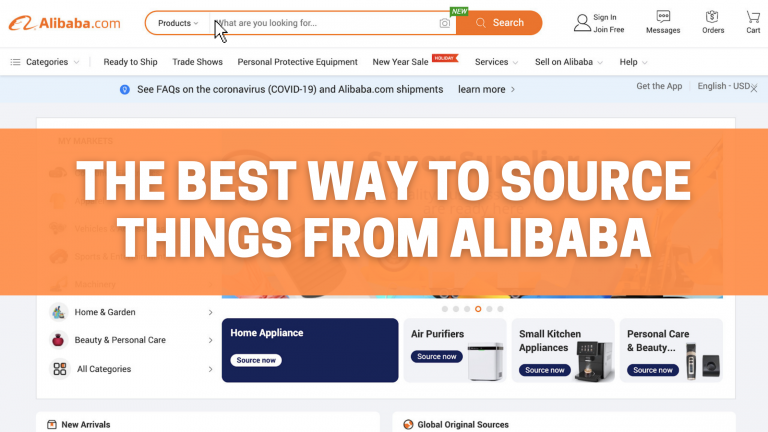These days, when it comes to sourcing products and finding suppliers, the first place everyone goes to is Alibaba.com.
Alibaba has 2.8 million suppliers listing items on their platform in over 5900 product categories.
If something is being made in a factory, you can find it on Alibaba.
It’s no surprise that Alibaba is one of the world’s most powerful companies. Its existence has a very large impact on the global world economy as we know it today.
The ability to connect Chinese suppliers and global entrepreneurs looking to source products is one of the main reasons third party eCommerce stores are as popular as they are right now.
Almost every seller on Amazon is sourcing products from suppliers they located on Alibaba. So, if you want to be a seller on Amazon, it’s pretty much a guarantee that you will find yourself browsing Alibaba at some point.
How to Conduct Proper Product Research
As we’ve established, it’s pretty much a guarantee that you will find any kind of product you are interested in sourcing on Alibaba.
Before you start looking, it’s important to have a really good idea of what it is that you wish to source. But making that decision is not exactly easy. Figuring out which product you want to sell on Amazon is the first and very possibly the most crucial step you need to take in your journey to start an Amazon business.
If you are a beginner, there are some guidelines you should follow when it comes to choosing your first product to sell on Amazon. We generally recommend you follow these guidelines:
Don’t Sell Anything Too Heavy or Bulky
A very important factor when it comes to finding the right product is how compact it is.
This is because the shipping cost as well as 2 of the 3 Amazon FBA fees (fulfillment and storage) are calculated based on size and weight.
This is why it’s best to stick to items that weigh no more than 2 to 5 lbs and don’t generally take up too much space.
Don’t Sell Products with Moving Parts
When it comes to items that might have a bit of complex design or functionality, it’s best to avoid them as a beginner. This is one of those things that might increase your cost of doing business.
Complex products with mechanical functions require stricter quality control. This is something that’s very much doable. However, as a beginner, you don’t want to complicate things too much.
Sell Products with Prices Between $15-$30
This is what is called a sweet spot for a first time private label seller.
Sourcing an item with a selling price below $15 will most likely leave you with slim to no profits. This is due to the fact that you would need to order an extremely high number of lower priced products to make it worthwhile. You don’t want to carry too many items or spend too much money at the start.
Also, with a higher selling price, the higher the manufacturing price. You want to place initial orders that are not too expensive and contain just enough units to last you until your next shipment, if they start selling rapidly.
Look for Products in High Demand
Of course, in order to know which product you want to sell, you should look at the ones that are selling well already.
If you are intent on selling on Amazon, Amazon is exactly where you ought to look. What you want to do is find a type of product that is selling well on Amazon and source something similar yourself. Ideally your product will be even more attractive than products that are already in that niche.
What you need is to find products that are selling well, in terms of revenue and units sold, that are not in niches that are over competitive and that have stable sales throughout the year.
It’s not easy to gather this information. You can’t collect it by just aimlessly browsing Amazon.
This is why people use sophisticated Amazon market intelligence tools. One of our favourites is AMZScout PRO Extension.
This piece of software allows you to “lift the curtain” and see the information that is hidden beneath the surface of any Amazon page:
Users can run the extension on any page and will see literally every piece of information they could possibly want to know.
This includes sales volume, sales history, margins, reviews, and more.
That way, you’ll have everything you need to know to see if your product is a winner or not. Check our article here for our complete product validation checklist!
You can also use a ton of special features such as the niche score that provides a breakdown of the niche as a whole in terms of your most important criteria.
Also, when it comes to Alibaba, there is a “find on Alibaba” button that will take you directly to Alibaba to search specifically for the type of product that you need.
6 Tips for Better Sourcing on Alibaba
Once you go through the process of figuring out which type of product you want to sell, the next step is to actually find someone on Alibaba that can make it for you.
Here are some tips about what to do and consider as you are doing this.
Make a List of Suppliers
The very first thing that you need to do is to find all of the possible candidates for your new supplier.
You can use advanced filters to be very specific in your search. A great tool that you can use in order to find some supplier candidates is the AMZScout PRO “Search Supplier on Alibaba.com” button.
Contact as Many Suppliers as Possible
After you make a list of all eligible suppliers, you can proceed to contact each and every one. You want to have as many options as you can get.
Look at Badges
Alibaba has a system which helps you to identify quality suppliers and they take it very seriously. There are three badges that you want to see on a manufacturer’s Alibaba page:
- Golden supplier: This is a supplier that has the “premium” version of a supplier account. It means that they are taking their presence on the platform seriously.
- Trade assurance: This badge means that if there are any issues with the shipment from that supplier in terms of delays or quality issues, you will be fully refunded. Their customers can rest easy with any transactions with this supplier.
- On site check: This badge means that the factory has been checked and verified by Alibaba and that there is no false representation by the company.
Ask the Right Questions
There are a number of things you need to learn from a perspective supplier:
- The MOQ: What is the minimum order quantity you can place.
- The price per unit related to order quantity: You need to know how placing larger orders in the future will affect the item manufacturing price. Working with a supplier is a long lasting relationship. It’s important to plan for the future and know what your margins would look like for larger orders.
- Product price related to shipping: It’s also important to know how much a shipment by air will cost vs a sea shipment and how long it takes for orders to arrive. Ask for their EXW (ex-works, i.e. manufacturer adds in their shipping costs & they will ship your product) and compare that to their FOB (free on board, i.e. manufacturer only makes the product while you handle shipping) price for their units.
- Customization options: You will be sourcing a type of product that already exists. However, you need to know if they can customize your product in the way that you need in order to stand out and be competitive in your niche.
- Tariffs: Your supplier will know if there are any tariffs associated with importing your product into wherever you will be selling it. This is good to know so you can calculate costs and adjust your price if needed.
- Any other documentation: If there are any Safety Data Sheets or other documentation you need in order to sell your product somewhere, your manufacturer will have those on hand.
The whole time you are going through this process, make sure to check the communication between you and your suppliers.
If they are upfront, on the ball, communicate clearly, and respond quickly to your messages, that is a great sign. If they do not tick these boxes, that is a huge red flag in our experience!
Some other red flags include:
- Not willing to accept Alibaba Trade Assurance.
- Wanting you to pay with Western Union.
- Refusing to send samples.
- No badges.
- Doesn’t have paid account.
Negotiate
The price your supplier quotes you at first is usually 15-20% marked up. That tells you how much wiggle room you have to negotiate it down.
In order to see if this is possible, you have to ask. Always be polite when you ask.
One strategy I see often is to screenshot what other companies are quoting you. Then, take the lowest price you get and relay this back to your other suppliers. See if they can beat that price. It’s up to you how many times you do this, but usually 1-2 times before ordering samples is good. You can repeat this after your samples have arrived another 1-2 times.
That said, price isn’t everything. If you try to undercut too much, you may force the manufacturer to cut costs, so you may end up with lower quality. Try to find a balance.
Order Samples
If the supplier seems to be meeting all of your demands, the next thing you should do is order samples from them.
If you have a few good supplier candidates, don’t shy away from ordering from several of them. This way, you can see for yourself if the product is up to your standard before committing to your first order.
Also, you will need the product sample to take product photos for your Amazon listing.
Once you’ve evaluated the samples, take note of which one you like best. Then, do another round of negotiations. As mentioned, don’t necessarily go for the lowest price, but instead you can leverage whoever has the lowest price to try and reduce the price of whomever you like best. That way, you will be able to strike a balance between quality and price.
Conclusion
If you are intending to sell on Amazon, Alibaba is the best place for you to find a supplier that can bring your product to life.
What is important is that you do proper product research beforehand and make sure that you have a solid product idea to bring to market.
If you’re not sure where to start, check out our article here if you need help with product research.
At that point, you need to find the right people to entrust with manufacturing. Make sure that you contact as many suppliers as you can, and prioritize the ones that communicate well.
Also, don’t be afraid to ask the right questions and to negotiate.
If you put in the effort, you will be rewarded with a sample of the product you want, and find one that you will be happy to sell on Amazon. Good luck sellers!



